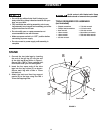
8
MINIMUM GAUGE EXTENSION CORD
RECOMMENDED SIZES FOR USE WITH STATIONARY ELECTRIC MACHINES
Ampere
Rating
Volts Total Length of
Cord in Feet
Gauge of
Extension Cord
0-6
0-6
0-6
0-6
240
240
240
240
up to 50
50-100
100-200
200-300
18 AWG
16 AWG
16 AWG
14 AWG
6-10
6-10
6-10
6-10
240
240
240
240
up to 50
50-100
100-200
200-300
18 AWG
16 AWG
14 AWG
12 AWG
10-12
10-12
10-12
10-12
240
240
240
240
up to 50
50-100
100-200
200-300
16 AWG
16 AWG
14 AWG
12 AWG
12-16
12-16
240
240
up to 50
50-100
14 AWG
12 AWG
MINIMUM GAUGE EXTENSION CORD
RECOMMENDED SIZES FOR USE WITH STATIONARY ELECTRIC MACHINES
Ampere
Rating
Volts Total Length of
Cord in Feet
Gauge of
Extension Cord
0-6
0-6
0-6
0-6
120
120
120
120
up to 25
25-50
50-100
100-150
18 AWG
16 AWG
16 AWG
14 AWG
6-10
6-10
6-10
6-10
120
120
120
120
up to 25
25-50
50-100
100-150
18 AWG
16 AWG
14 AWG
12 AWG
10-12
10-12
10-12
10-12
120
120
120
120
up to 25
25-50
50-100
100-150
16 AWG
16 AWG
14 AWG
12 AWG
12-16 120 up to 25 14 AWG
12-16 120 25-50 12 AWG
12-16 120
GREATER THAN 50 FEET NOT RECOMMENDED
Never use a damaged extension cord. Check extension cords before each use. If damaged,
replace immediately. Touching the damaged area could case electrical shock resulting in serious injury.
Keep the extension cord clear of the work area. Position the cord so it will not get caught on lumber,
tools or other obstructions
• Use proper extension cords. Make sure your extension cord is a 3-wire extension cord which has a 3-prong
grounding type plug and matching receptacle which will accept the machine’s plug, as described in this manual’s
Grounding Instructions. When using an extension cord, be sure to use one heavy enough to carry the current of the
machine. An undersized cord will cause a drop in line voltage, resulting in loss of power and overheating. The table
below shows the maximum gauge to use depending on the cord length. If in doubt, use the next heavier gauge. The
smaller the gauge number, the heavier the cord. Only round, jacketed cords listed by Underwriter’s Laboratories (UL)
should be used.
Check with a qualified electrician or service personnel
if the grounding instructions are not completely
understood, or if in doubt as to whether the machine is
properly grounded.
Use only 3-wire extension cords that have 3-prong
grounding type plugs and matching, properly grounded
3-conductor receptacles that accept the machine’s
plug, as shown in Figure A, or a properly grounded
receptacle with a grounding means adaptor, as shown
in Figure B.
Repair or replace damaged or worn cord immediately.
IN ALL CASES, MAKE CERTAIN THE RECEPTACLE IN QUESTION IS PROPERLY GROUNDED. IF
YOU ARE NOT SURE, HAVE A qualified ELECTRICIAN CHECK THE RECEPTACLE.
POWER CONNECTIONS
(continued)
This is a grounded, cord-connected tool intended for use on a supply circuit having a nominal voltage of 120 volts.
It is intended to for use on a circuit that has an outlet as shown in FIG. A. It has a plug as shown in FIG A. If you
have a 2 pole receptacle as shown in FIG. B you may use a temporary adapter, as shown in FIG. B. if a properly
grounded outlet is not available. The green ear lug extending from the adapter must be connected to a permanent
grounded outlet box. The temporary adapter should be used only until a properly grounded outlet can be installed
by a qualified electrician.
This tool may be converted to 240 volt power supply circuit by a qualified electrician. If it is converted to 240 volts
it must be equipped with a grounding plug shown in FIG. C and must be connected to an outlet as shown in FIG. C,
which is connected to a permanent ground. No adapter is available or should be used with this tool when converted
to 240 volts.
EXTENSION CORDS
FIG. A
CURRENT
CARRYING
PRONGS
GROUNDING BLADE
IS LONGEST OF THE 3 BLADES
GROUNDED
OUTLET BOX
FIG. B
ADAPTER
GROUNDED OUTLET BOX
GROUNDING
MEANS
FIG. C
Grounding Pin


















